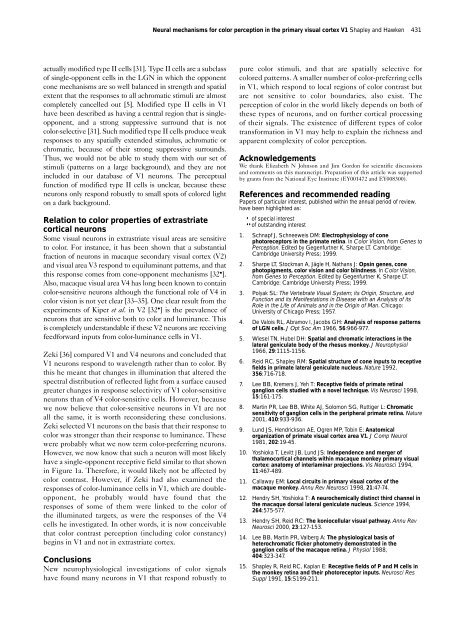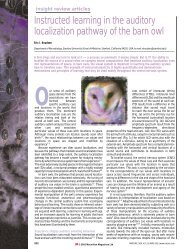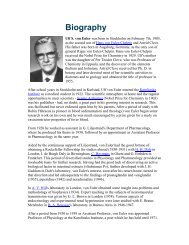Neural mechanisms for color perception in the primary visual cortex
Neural mechanisms for color perception in the primary visual cortex
Neural mechanisms for color perception in the primary visual cortex
Create successful ePaper yourself
Turn your PDF publications into a flip-book with our unique Google optimized e-Paper software.
<strong>Neural</strong> <strong>mechanisms</strong> <strong>for</strong> <strong>color</strong> <strong>perception</strong> <strong>in</strong> <strong>the</strong> <strong>primary</strong> <strong>visual</strong> <strong>cortex</strong> V1 Shapley and Hawken 431<br />
actually modified type II cells [31]. Type II cells are a subclass<br />
of s<strong>in</strong>gle-opponent cells <strong>in</strong> <strong>the</strong> LGN <strong>in</strong> which <strong>the</strong> opponent<br />
cone <strong>mechanisms</strong> are so well balanced <strong>in</strong> strength and spatial<br />
extent that <strong>the</strong> responses to all achromatic stimuli are almost<br />
completely cancelled out [5]. Modified type II cells <strong>in</strong> V1<br />
have been described as hav<strong>in</strong>g a central region that is s<strong>in</strong>gleopponent,<br />
and a strong suppressive surround that is not<br />
<strong>color</strong>-selective [31]. Such modified type II cells produce weak<br />
responses to any spatially extended stimulus, achromatic or<br />
chromatic, because of <strong>the</strong>ir strong suppressive surrounds.<br />
Thus, we would not be able to study <strong>the</strong>m with our set of<br />
stimuli (patterns on a large background), and <strong>the</strong>y are not<br />
<strong>in</strong>cluded <strong>in</strong> our database of V1 neurons. The perceptual<br />
function of modified type II cells is unclear, because <strong>the</strong>se<br />
neurons only respond robustly to small spots of <strong>color</strong>ed light<br />
on a dark background.<br />
Relation to <strong>color</strong> properties of extrastriate<br />
cortical neurons<br />
Some <strong>visual</strong> neurons <strong>in</strong> extrastriate <strong>visual</strong> areas are sensitive<br />
to <strong>color</strong>. For <strong>in</strong>stance, it has been shown that a substantial<br />
fraction of neurons <strong>in</strong> macaque secondary <strong>visual</strong> <strong>cortex</strong> (V2)<br />
and <strong>visual</strong> area V3 respond to equilum<strong>in</strong>ant patterns, and that<br />
this response comes from cone-opponent <strong>mechanisms</strong> [32 • ].<br />
Also, macaque <strong>visual</strong> area V4 has long been known to conta<strong>in</strong><br />
<strong>color</strong>-sensitive neurons although <strong>the</strong> functional role of V4 <strong>in</strong><br />
<strong>color</strong> vision is not yet clear [33–35]. One clear result from <strong>the</strong><br />
experiments of Kiper et al. <strong>in</strong> V2 [32 • ] is <strong>the</strong> prevalence of<br />
neurons that are sensitive both to <strong>color</strong> and lum<strong>in</strong>ance. This<br />
is completely understandable if <strong>the</strong>se V2 neurons are receiv<strong>in</strong>g<br />
feed<strong>for</strong>ward <strong>in</strong>puts from <strong>color</strong>-lum<strong>in</strong>ance cells <strong>in</strong> V1.<br />
Zeki [36] compared V1 and V4 neurons and concluded that<br />
V1 neurons respond to wavelength ra<strong>the</strong>r than to <strong>color</strong>. By<br />
this he meant that changes <strong>in</strong> illum<strong>in</strong>ation that altered <strong>the</strong><br />
spectral distribution of reflected light from a surface caused<br />
greater changes <strong>in</strong> response selectivity of V1 <strong>color</strong>-sensitive<br />
neurons than of V4 <strong>color</strong>-sensitive cells. However, because<br />
we now believe that <strong>color</strong>-sensitive neurons <strong>in</strong> V1 are not<br />
all <strong>the</strong> same, it is worth reconsider<strong>in</strong>g <strong>the</strong>se conclusions.<br />
Zeki selected V1 neurons on <strong>the</strong> basis that <strong>the</strong>ir response to<br />
<strong>color</strong> was stronger than <strong>the</strong>ir response to lum<strong>in</strong>ance. These<br />
were probably what we now term <strong>color</strong>-preferr<strong>in</strong>g neurons.<br />
However, we now know that such a neuron will most likely<br />
have a s<strong>in</strong>gle-opponent receptive field similar to that shown<br />
<strong>in</strong> Figure 1a. There<strong>for</strong>e, it would likely not be affected by<br />
<strong>color</strong> contrast. However, if Zeki had also exam<strong>in</strong>ed <strong>the</strong><br />
responses of <strong>color</strong>-lum<strong>in</strong>ance cells <strong>in</strong> V1, which are doubleopponent,<br />
he probably would have found that <strong>the</strong><br />
responses of some of <strong>the</strong>m were l<strong>in</strong>ked to <strong>the</strong> <strong>color</strong> of<br />
<strong>the</strong> illum<strong>in</strong>ated targets, as were <strong>the</strong> responses of <strong>the</strong> V4<br />
cells he <strong>in</strong>vestigated. In o<strong>the</strong>r words, it is now conceivable<br />
that <strong>color</strong> contrast <strong>perception</strong> (<strong>in</strong>clud<strong>in</strong>g <strong>color</strong> constancy)<br />
beg<strong>in</strong>s <strong>in</strong> V1 and not <strong>in</strong> extrastriate <strong>cortex</strong>.<br />
Conclusions<br />
New neurophysiological <strong>in</strong>vestigations of <strong>color</strong> signals<br />
have found many neurons <strong>in</strong> V1 that respond robustly to<br />
pure <strong>color</strong> stimuli, and that are spatially selective <strong>for</strong><br />
<strong>color</strong>ed patterns. A smaller number of <strong>color</strong>-preferr<strong>in</strong>g cells<br />
<strong>in</strong> V1, which respond to local regions of <strong>color</strong> contrast but<br />
are not sensitive to <strong>color</strong> boundaries, also exist. The<br />
<strong>perception</strong> of <strong>color</strong> <strong>in</strong> <strong>the</strong> world likely depends on both of<br />
<strong>the</strong>se types of neurons, and on fur<strong>the</strong>r cortical process<strong>in</strong>g<br />
of <strong>the</strong>ir signals. The existence of different types of <strong>color</strong><br />
trans<strong>for</strong>mation <strong>in</strong> V1 may help to expla<strong>in</strong> <strong>the</strong> richness and<br />
apparent complexity of <strong>color</strong> <strong>perception</strong>.<br />
Acknowledgements<br />
We thank Elizabeth N Johnson and Jim Gordon <strong>for</strong> scientific discussions<br />
and comments on this manuscript. Preparation of this article was supported<br />
by grants from <strong>the</strong> National Eye Institute (EY001472 and EY008300).<br />
References and recommended read<strong>in</strong>g<br />
Papers of particular <strong>in</strong>terest, published with<strong>in</strong> <strong>the</strong> annual period of review,<br />
have been highlighted as:<br />
• of special <strong>in</strong>terest<br />
•• of outstand<strong>in</strong>g <strong>in</strong>terest<br />
1. Schnapf J, Schneeweis DM: Electrophysiology of cone<br />
photoreceptors <strong>in</strong> <strong>the</strong> primate ret<strong>in</strong>a. In Color Vision, from Genes to<br />
Perception. Edited by Gegenfurtner K, Sharpe LT. Cambridge:<br />
Cambridge University Press; 1999.<br />
2. Sharpe LT, Stockman A, Jägle H, Nathans J: Ops<strong>in</strong> genes, cone<br />
photopigments, <strong>color</strong> vision and <strong>color</strong> bl<strong>in</strong>dness. In Color Vision,<br />
from Genes to Perception. Edited by Gegenfurtner K, Sharpe LT.<br />
Cambridge: Cambridge University Press; 1999.<br />
3. Polyak SL: The Vertebrate Visual System; its Orig<strong>in</strong>, Structure, and<br />
Function and its Manifestations <strong>in</strong> Disease with an Analysis of its<br />
Role <strong>in</strong> <strong>the</strong> Life of Animals and <strong>in</strong> <strong>the</strong> Orig<strong>in</strong> of Man. Chicago:<br />
University of Chicago Press; 1957.<br />
4. De Valois RL, Abramov I, Jacobs GH: Analysis of response patterns<br />
of LGN cells. J Opt Soc Am 1966, 56:966-977.<br />
5. Wiesel TN, Hubel DH: Spatial and chromatic <strong>in</strong>teractions <strong>in</strong> <strong>the</strong><br />
lateral geniculate body of <strong>the</strong> rhesus monkey. J Neurophysiol<br />
1966, 29:1115-1156.<br />
6. Reid RC, Shapley RM: Spatial structure of cone <strong>in</strong>puts to receptive<br />
fields <strong>in</strong> primate lateral geniculate nucleus. Nature 1992,<br />
356:716-718.<br />
7. Lee BB, Kremers J, Yeh T: Receptive fields of primate ret<strong>in</strong>al<br />
ganglion cells studied with a novel technique. Vis Neurosci 1998,<br />
15:161-175.<br />
8. Mart<strong>in</strong> PR, Lee BB, White AJ, Solomon SG, Ruttiger L: Chromatic<br />
sensitivity of ganglion cells <strong>in</strong> <strong>the</strong> peripheral primate ret<strong>in</strong>a. Nature<br />
2001, 410:933-936.<br />
9. Lund JS, Hendrickson AE, Ogren MP, Tob<strong>in</strong> E: Anatomical<br />
organization of primate <strong>visual</strong> <strong>cortex</strong> area V1. J Comp Neurol<br />
1981, 202:19-45.<br />
10. Yoshioka T, Levitt JB, Lund JS: Independence and merger of<br />
thalamocortical channels with<strong>in</strong> macaque monkey <strong>primary</strong> <strong>visual</strong><br />
<strong>cortex</strong>: anatomy of <strong>in</strong>terlam<strong>in</strong>ar projections. Vis Neurosci 1994,<br />
11:467-489.<br />
11. Callaway EM: Local circuits <strong>in</strong> <strong>primary</strong> <strong>visual</strong> <strong>cortex</strong> of <strong>the</strong><br />
macaque monkey. Annu Rev Neurosci 1998, 21:47-74.<br />
12. Hendry SH, Yoshioka T: A neurochemically dist<strong>in</strong>ct third channel <strong>in</strong><br />
<strong>the</strong> macaque dorsal lateral geniculate nucleus. Science 1994,<br />
264:575-577.<br />
13. Hendry SH, Reid RC: The koniocellular <strong>visual</strong> pathway. Annu Rev<br />
Neurosci 2000, 23:127-153.<br />
14. Lee BB, Mart<strong>in</strong> PR, Valberg A: The physiological basis of<br />
heterochromatic flicker photometry demonstrated <strong>in</strong> <strong>the</strong><br />
ganglion cells of <strong>the</strong> macaque ret<strong>in</strong>a. J Physiol 1988,<br />
404:323-347.<br />
15. Shapley R, Reid RC, Kaplan E: Receptive fields of P and M cells <strong>in</strong><br />
<strong>the</strong> monkey ret<strong>in</strong>a and <strong>the</strong>ir photoreceptor <strong>in</strong>puts. Neurosci Res<br />
Suppl 1991, 15:S199-211.





